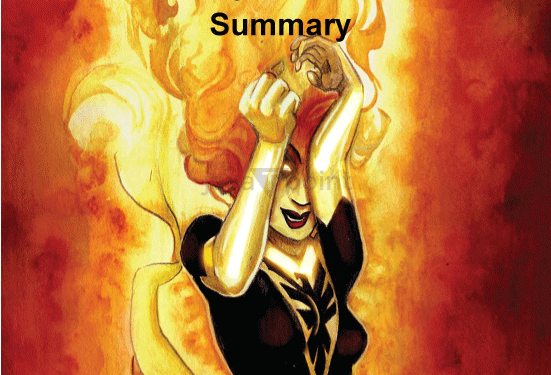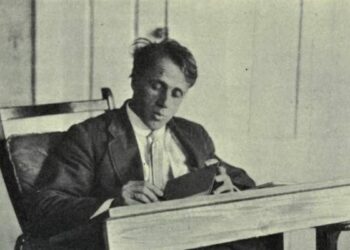Lady Lazarus Poem Summary
- “I have done it again.”
- The speaker of the poem opens with an authoritative and forthright declaration that alluded to a repeated behavior.
- “One year in every ten I manage it—”
- The speaker suggests a cyclical pattern by revealing that this act happens once every ten years.
- “A sort of walking miracle, my skin”
- Speaking of oneself as a “walking miracle,” the speaker conveys tenacity or survival. The physical body may be referenced by the emphasis on “skin”.
- “Bright as a Nazi lampshade,”
- A dark and eerie touch is added by the metaphor of a Nazi lampshade, which implies a link between the speaker’s experiences and past tragedies.
- “My right foot”
- The speaker’s actions’ physical cost is hinted at by the attention on a particular bodily portion.
- “A paperweight,”
- The comparison of the foot to a paperweight implies a sense of weight or burden.
- “My face a featureless, fine”
- The speaker’s face is described as “featureless,” perhaps indicating a loss of identity or a mask-like appearance.
- “Jew linen.”
- The reference to “Jew linen” adds another layer of historical and cultural significance, connecting to the speaker’s complex identity.
- “Peel off the napkin”
- The act of peeling off a napkin suggests an unveiling or exposure, perhaps metaphorically revealing hidden aspects of the speaker’s self.
- “O my enemy.”
- The speaker addresses an unspecified enemy, introducing a confrontational tone and suggesting internal or external conflicts.
- “Do I terrify?”
- The speaker questions whether her existence or actions inspire fear in others, acknowledging the impact of her presence.
- “The sour breath”
- The use of “sour breath” adds a visceral and uncomfortable element, evoking a sense of decay or deterioration.
- “Will vanish in a day.”
- The transient nature of the sour breath implies a temporary discomfort, perhaps contrasting with the more enduring aspects of the speaker’s experiences.
- “Soon, soon the flesh”
- The repetition of “soon” creates a sense of urgency. The focus on flesh suggests a connection to the physical body.
- “The grave cave ate will be at home on me”
- The imagery of the “grave cave” suggests a burial or entombment. The idea of it being “at home” on the speaker hints at a familiarity with death.
- “And I a smiling woman.”
- Despite the morbid imagery, the speaker envisions herself as a smiling woman, introducing an ironic or unsettling contrast.
- “I am only thirty.”
- The speaker reveals her age, emphasizing the juxtaposition of youth and the contemplation of mortality.
- “And like the cat I have nine times to die.”
- The cat’s nine lives serve as a metaphor for the speaker’s repeated experiences of “death” or near-death.
- “This is Number Three.”
- The speaker enumerates one of her experiences, indicating a familiarity with these cycles.
- “What a trash”
- The use of “trash” suggests a dismissive or devalued view of the speaker’s own experiences.
- “To annihilate each decade.”
- The word “annihilate” underscores the intensity of the speaker’s experiences, suggesting a deliberate and forceful act of self-destruction.
- “What, what?”
- The repetition of “what” emphasizes the speaker’s internal questioning and confusion.
- “So that the ears”
- The focus on the ears suggests a heightened sensitivity or awareness.
- “But it took a fine”
- The mention of a “fine” introduces a financial or punitive element, adding to the complexity of the speaker’s relationship with society.
- “I may be a bit of a Jew.”
- The speaker’s assertion of being “a bit of a Jew” connects to earlier references, possibly exploring themes of identity and heritage.
- “I have always been scared of you,”
- The speaker confesses a fear of an unspecified “you,” acknowledging an external source of anxiety.
- “With your Luftwaffe, your gobbledygoo.”
- The reference to “Luftwaffe” (the German air force in World War II) and “gobbledygoo” adds historical and linguistic elements, possibly highlighting the speaker’s complex relationship with language and power.
- “And your neat mustache”
- The mention of a “neat mustache” invokes an image associated with authority figures, possibly alluding to oppressive forces.
- “And your Aryan eye, bright blue.”
- The reference to an “Aryan eye, bright blue” continues the exploration of identity and racial themes, invoking historical associations.
- “Panzer-man, panzer-man, O You—”
- The repetition of “panzer-man” references a tank or armored vehicle, introducing militaristic imagery.
- “Not God but a swastika”
- The speaker rejects the conventional notion of God, instead associating a swastika with a symbol of power, but also one laden with historical connotations.
- “So black no sky could squeak through.”
- The darkness described is impenetrable, emphasizing a sense of suffocation or suppression.
- “Every woman adores a Fascist,”
- The speaker makes a provocative statement, challenging societal expectations or norms related to attraction.
- “The boot in the face, the brute”
- The harsh imagery of a boot in the face and the term “brute” suggests violence and oppression.
- “Brute heart of a brute like you.”
- The repetition of “brute” underscores the dehumanizing characterization of the addressed figure.
- “You stand at the blackboard, daddy,”
- The poem shifts to addressing a figure as “daddy,” introducing a more personal and intimate tone.
- “In the picture I have of you,”
- The speaker refers to a mental image of the addressed figure, highlighting the role of memory and perception.
- “A cleft in your chin instead of your foot”
- The shift from a “cleft in your chin” to the earlier image of the speaker’s foot suggests an inversion or transformation.
- “But no less a devil for that, no not”
- The acknowledgment of devilish qualities challenges conventional notions of good and evil.
- “Any less the black man who”
- The introduction of the “black man” adds racial dimensions to the poem, complicating the narrative.
- “Bit my pretty red heart in two.”
- The imagery of the “black man” biting the speaker’s heart in two introduces a visceral and violent image, symbolizing emotional pain.
- “I was ten when they buried you.”
- The speaker mentions a significant age (ten) in relation to the burial of the addressed figure, suggesting an early encounter with mortality.
- “At twenty I tried to die”
- The speaker references a suicide attempt at the age of twenty, highlighting a pivotal moment in her life.
- “And get back, back, back to you.”
- The desire to “get back” suggests a complex emotional attachment or connection to the addressed figure.
- “I thought even the bones would do.”
- The speaker contemplates a return to the addressed figure even in death, emphasizing the strength of the emotional bond.
- “But they pulled me out of the sack,”
- The mention of being pulled out of a sack suggests confinement or a suffocating situation.
- “And they stuck me together with glue.”
- The imagery of being stuck together with glue introduces a sense of fragmentation and attempted repair.
- “And then I knew what to do.”
- The speaker’s realization suggests a newfound clarity or purpose.
- “I made a model of you,”
- The speaker engages in a creative act of making a model, possibly as a means of coping or processing emotions.
- “A man in black with a Meinkampf look”
- The description of the model introduces an ominous figure reminiscent of the historical context of “Mein Kampf.”
- “And a love of the rack and the screw.”
- The reference to the rack and the screw suggests torture or punishment, adding to the disturbing nature of the image.
- “And I said I do, I do.”
- The repetition of “I do” may allude to a sense of compliance or submission, possibly linked to societal expectations.
- “So daddy, I’m finally through.”
- The speaker declares completion, suggesting a resolution or conclusion to a process.
- “The black telephone’s off at the root,”
- The metaphor of the black telephone being “off at the root” implies a disconnection or breakdown in communication.
- “The voices just can’t worm through.”
- The inability of voices to “worm through” emphasizes a sense of isolation or a barrier to communication.
- “If I’ve killed one man, I’ve killed two—”
- The admission of killing one man and then two suggests a multiplication of guilt or a cascade of consequences.
- “The vampire who said he was you”
- The introduction of the vampire figure complicates the narrative, adding layers of symbolism and ambiguity.
- “And drank my blood for a year,”
- The imagery of drinking blood reinforces the vampiric motif, possibly symbolizing a parasitic relationship.
- “Seven years, if you want to know.”
- The specific duration emphasizes the prolonged nature of this metaphorical vampiric relationship.
- “Daddy, you can lie back now.”
- The command to “lie back” suggests a surrender or cessation of struggle.
- “There’s a stake in your fat black heart”
- The image of a stake in the heart alludes to vampire lore and introduces an element of retribution or punishment.
- “And the villagers never liked you.”
- The reference to villagers not liking the addressed figure adds a societal dimension, hinting at societal judgment or rejection.
- “They are dancing and stamping on you.”
- The vivid image of villagers dancing and stamping on the figure implies a collective response to perceived wrongdoing.
- “They always knew it was you.”
- The assertion that “they always knew it was you” suggests a sense of inevitability or recognition of guilt.
- “Daddy, daddy, you bastard, I’m through.”
- The repetition of “Daddy” followed by a declaration of being through indicates a decisive and possibly cathartic moment of finality.
Also Read-
- Touched by an Angel Poem Summary line by line
- Pantoun for Chinese Women Poem Summary line by line
- The Children of the Poor Poem Summary line by line
Lady Lazarus Poem
Conclusion
In Sylvia Plath’s “Lady Lazarus,” the poet crafts a visceral and emotionally charged exploration of personal struggles, mortality, and societal expectations. The poem, written in Plath’s confessional style, delves into the complexities of the speaker’s psyche, revealing a turbulent relationship with identity, authority figures, and a pervasive sense of mortality. The recurring imagery of death, resurrection, and the vampiric metaphor creates a vivid and haunting narrative that resonates with readers on both an emotional and intellectual level. Plath’s use of historical references, particularly to the Nazi regime, adds layers of cultural and symbolic significance, contributing to the poem’s depth and complexity. Ultimately, “Lady Lazarus” stands as a powerful and evocative work that invites reflection on the profound intersections of personal experience and wider historical and societal contexts.
FAQ:
1. What is the significance of the Nazi imagery in “Lady Lazarus”?
The Nazi imagery in “Lady Lazarus” adds historical and cultural depth to the poem. The reference to a “Nazi lampshade” and other elements may symbolize the oppressive forces that have affected the speaker, contributing to the overall theme of struggle and resistance.
2. Why does the speaker refer to herself as “Lady Lazarus”?
The reference to “Lady Lazarus” draws parallels with the biblical figure Lazarus, who was raised from the dead by Jesus. The speaker adopts this persona to explore themes of resurrection, survival, and the cyclical nature of her struggles with mental health and mortality.
3. What is the significance of the vampire imagery in the poem?
The vampire imagery in the poem introduces a metaphorical element, suggesting parasitic relationships, emotional draining, and possibly exploring the theme of unhealthy dependencies in the speaker’s life.
4. How does Plath use language to convey the emotional intensity of the poem?
Plath employs vivid and emotionally charged language throughout the poem. The use of stark imagery, powerful metaphors, and a confessional tone creates an intense emotional atmosphere, allowing readers to empathize with the speaker’s internal struggles.
5. What role does societal judgment play in “Lady Lazarus”?
Societal judgment is a significant theme in the poem, particularly in the lines where the villagers are described as dancing and stamping on the figure. This suggests a collective response to the speaker’s actions, highlighting the impact of societal expectations and the consequences of not conforming to them.

















